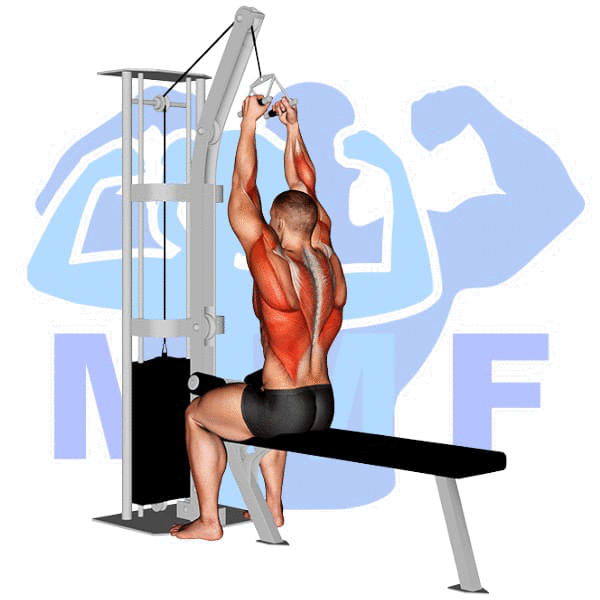If you’ve ever struggled with building upper body strength, chances are you’ve tried the dumbbell bench press at some point. While it’s a great exercise for targeting the chest, shoulders, and triceps, it can be challenging to execute properly without experiencing discomfort or even pain. The reality is, many gym-goers struggle with mastering the correct form of the dumbbell bench press. But don’t worry, you’re not alone! The good news is, with practice and a few tweaks to your technique, you can perfect this exercise and reap its benefits. In this post, we’ll explore the problem behind the discomfort, offer some tips to prevent it, and help you master the dumbbell bench press once and for all.
Dumbbell Bench Press Summary
- Primary Muscles: Pectoralis Major – Sternal
- Secondary Muscles: Deltoid – Anterior, Pectoralis Major – Clavicular, and Triceps Brachii
- Equipment: Dumbbells and Bench
- Mechanics Type: Compound
- Force: Push
- Utility: Basic

Dumbbell Bench Press Instructions
- Grasp two dumbbells with an overhand grip.
- Sit down on the bench with dumbbells resting on lower thigh.
- Kick weights to shoulder and lie back facing up on the bench, with the knees bent to 90 degrees and the feet firmly on the floor. If the feet do not reach the ground, only then can you put them on the bench. The shoulder and elbow joints should both be at a 90-degree angle.
- Position the dumbbells to the sides of your upper chest with elbows under dumbbells.
- Arch the back slightly, tighten the abs and retract the scapulas. Make sure that the glutes stay in contact with the bench throughout the lift. Inhale and hold your breath.
- Feet are kept flat on the floor, weight on the heels, lower leg perpendicular to the floor, with the buttocks always in contact with the bench. Proper position prevents extreme arching of your lower back.
- Forcefully exhale as you push the dumbbells straight up until your elbows are extended.
- Squeeze the chest.
- Inhale as you slowly lower the dumbbells to the starting position.
- Repeat.
Video Tutorial
Dumbbell Bench Press Muscles
Target (Agonist)
- Pectoralis Major, Sternal
Synergists
- Deltoid – Anterior
- Pectoralis Major – Clavicular
- Triceps Brachii
Dynamic Stabilizers
- Biceps Brachii – Short Head
Stabilizers
- Pectoralis Minor
- Serratus Anterior
Antagonist Stabilizers
- None

Benefits of Dumbbell Bench Press
The Dumbbell Bench Press is an effective exercise for developing the strength and size of the Pectoralis Major – Sternal muscle. This exercise can be done with a barbell or dumbbells and targets the chest, shoulders, and triceps muscles. When performed correctly, this exercise can help to increase overall strength, promote improved posture, and even reduce the risk of injury. Furthermore, the Dumbbell Bench Press can help to promote muscular balance between the left and right sides of the body, which is important for preventing muscular imbalances.
Tips for Performing Dumbbell Bench Press
If you’d like sustained results, you will need to stick to these easy tips. Also, if you want to reduce the chance of getting an injury, these tips are for you.
- Utilize Full Range Of Motion. When you use complete range of motion you will certainly ensure that that you strain the complete muscle and that you sustain your flexibility.
- Allow For Recovery. Allowing a rest of 90 seconds to 3 minutes should allow you to complete a full set.
- Go Slow For Better Results. Slowing each repetition to about 5 seconds per contraction and extension, can accelerate your training. To generate mass you need to increase the amount of time under tension of your target muscle tissue. Slowing your execution will raise the amount of time under strain. Frequent research papers have found that just under 6 seconds extension and contraction is the ideal time provides maximal benefit for creating muscle gains. You want to incorporate this technique on occasion, but not every time you train.
- Control Breathing. Breathe in when you extend your muscle tissues and exhale when you contract your muscle.
- Use a spotter. A spotter can help monitor your form and also help you get those last few reps out!
- Begin with a lightweight to practice proper form and control and adequately warm up the shoulder girdle.
- Use a Smooth and Controlled Motion. A controlled movement will avoid cheating which in turn will take the emphasis off the chest.
- Do Not Arch Your Back and Your Raise the Glutes Off The Bench. Compress the stomach muscles to force the lower back down, or bring legs up and flat onto the bench (beginners should keep the feet on the floor because otherwise, they may lose their balance).
Benefits and Tips Video
Frequent Mistakes To Avoid
You want to keep from making these very common errors. Preventing these mistakes will improve your form and help you continue to develop gains. Also, you reduce the prospect of developing an injury.
- Using too Much Weight. A common mistake for many novice lifters is lifting too much. Lifting too heavy can result in poor form and possible injuries. Make sure to use a correct weight that will allow you to use proper form and the full range of motion.
- Bouncing and Jerking the Weight. Jerking or bouncing is also referred to as cheating and will take the emphasis off the chest. It can also result in losing control of the load leading to injuries.
- Losing Control of the Weight. You can pull ligaments and hurt your rotator cuff.
- Going too fast. Performing the action too quickly doesn’t allow you to recruit as many muscle fibers fully.
- Compromise Range of Motion. Going too deep if you have limited motion or are not adequately warmed up and stretched can result in a serious tendon, joint and muscle injury. Not using a full range of motion can also compromise results.
- Don’t Skip Recovery. Over-training can easily in fact make you weaker in lieu stronger.
- Cheating. In nearly all cases, cheating is utilizing momentum as a substitute for the force of your main muscle. Occasionally, some cheating on your final rep can be beneficial to overload your muscle, although not for more than a small number of reps.
- Working Out Alone. Your workout buddy is usually a fantastic motivator. A partner can certainly be also valuable spotter.
Find More Dumbbell Exercises Here
Variations and Complementary Exercises
There are numerous variations, complementary, and alternative exercises for the Dumbbell Bench Press that can be used to target similar muscles. These exercises can be used to challenge the muscles in a different way, to provide variety, or to work around an injury. The following list includes some of the most popular variations, complementary, and alternative exercises for the Dumbbell Bench Press.
Dumbbell Reverse Grip Bench Press
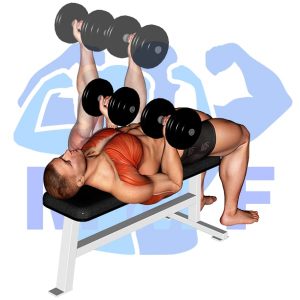
The Dumbbell Reverse Grip Bench Press is an excellent complementary or alternative exercise to the Dumbbell Bench Press. This exercise strengthens the chest, triceps, and shoulders while still targeting the same muscles as the Dumbbell Bench Press. It is an excellent exercise for both increasing strength and muscular endurance. The Reverse Grip variation focuses more on the triceps than the traditional Dumbbell Bench Press, so it is great for athletes looking to build tricep strength and size. Additionally, because of the grip used in the exercise, it helps to reduce strain on the shoulders, making it a great exercise for those with shoulder injuries.
Barbell Bench Press
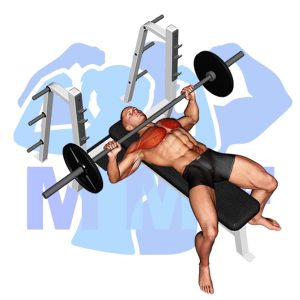
The Barbell Bench Press is a great complementary or alternative exercise for the Dumbbell Bench Press. It is an upper body exercise that works the chest, shoulders, and triceps and can be performed with a barbell or with dumbbells. The Barbell Bench Press is a great way to increase strength, power, and explosiveness. This exercise also requires a greater range of motion than the Dumbbell Bench Press, making it more effective at targeting the chest and triceps muscles. The Barbell Bench Press also offers the benefit of increasing core stability, as the weight is distributed evenly across both sides of the body.
Barbell Wide Reverse Grip Bench Press

The Barbell Wide Reverse Grip Bench Press is a great complementary or alternative exercise to the Dumbbell Bench Press. This exercise is performed by gripping the barbell wider than shoulder-width apart and in a reverse grip. This increases the range of motion and therefore increases the difficulty of the exercise. It also works the chest muscles in a different way than the Dumbbell Bench Press, making it an ideal addition to any strength-training routine. Additionally, the Barbell Wide Reverse Grip Bench Press is a great way to increase overall shoulder stability and core strength, making it a great alternative or complementary exercise to the Dumbbell Bench Press.
Check Out These Top Dumbbell Exercises
Barbell Decline Wide Grip Press
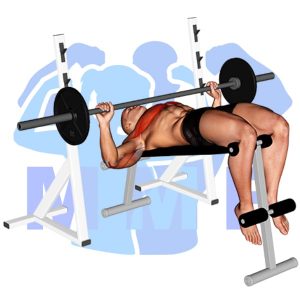
The Barbell Decline Wide Grip Press is an excellent complementary or alternative exercise to the Dumbbell Bench Press. This exercise works the muscles of the chest, shoulders, and triceps, but with a greater emphasis on the lower chest. The wide grip also puts more stress on the shoulders and triceps, making it a great way to mix up your chest routine. Additionally, this exercise can help increase your bench press strength by providing an alternative stimulus to the same muscle groups.
Barbell Wide Bench Press

The barbell wide bench press is a great alternative or complementary exercise to the dumbbell bench press. This exercise involves holding the barbell wider than shoulder width apart, and pressing the weight up from the chest. It is a great way to target the chest, shoulders, and triceps muscles, as the wider grip increases muscle activation in those areas. Additionally, it is a great exercise to build upper body strength and muscle size. It also can help to reduce shoulder pain as it forces the user to use proper form and technique.
Cable Chest Press

The cable chest press is an excellent alternative or complementary exercise to the dumbbell bench press. It involves lying on a flat bench while gripping a cable machine handle attached to a weight stack. This exercise is beneficial because it allows the user to work out with a constant tension throughout the range of motion, which helps to stimulate muscle growth. Additionally, the cable chest press works both the upper and lower chest muscles, whereas the dumbbell bench press focuses mainly on the upper chest muscles. This makes it an excellent choice for targeting both areas for more balanced development.
Find More Chest Exercises Here
Opposing Complementary Exercises
These exercises will target the opposing muscle groups of the Dumbbell Bench Press to ensure you are developing an even and balanced physique. When performing a bench press, the primary muscles used are the chest, shoulders, and triceps. To effectively strengthen and build these muscles, it is important to also target the opposing muscles, such as the back and biceps. The following exercises will help to build strength and balance in these opposing muscle groups.
Barbell Bent Over Row

The Barbell Bent Over Row is a great exercise to complement the Dumbbell Bench Press. It works the opposing muscle group of the back, which helps to create balance in the upper body. This exercise strengthens the back muscles, including the lats, trapezius, and rhomboids. It also improves posture, stability and balance, while helping to prevent injury. This exercise is great for developing strength and increasing muscle mass in the back, while helping to create a balanced physique.
Barbell Rear Delt Row
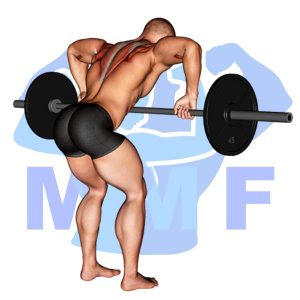
The Barbell Rear Delt Row is a great complementary exercise to the Dumbbell Bench Press. This exercise targets the back muscles, specifically the rear delts, which are the opposing muscle group to the chest muscles worked by the Dumbbell Bench Press. By incorporating both exercises into your workout routine, you can ensure that your muscles are getting a balanced workout. The Barbell Rear Delt Row is performed by gripping the barbell with an overhand grip, slightly wider than shoulder-width apart. You will then pull the barbell up towards your chest while keeping your back straight and core tight. This exercise will help to strengthen your back muscles and create balance in your upper body strength.
Cable Crossover Reverse Flys

Cable Crossover Reverse Flys are an excellent complementary exercise to the Dumbbell Bench Press. This exercise works the opposing muscle group by isolating the back muscles and putting them under tension. It helps to balance out the strength and development of the chest and back muscles, as well as adding stability to the shoulder joint. The Cable Crossover Reverse Flys provides a great range of motion and allows for a full contraction of the back muscles, which helps to improve posture and shoulder stability. It is an effective way to strengthen the back muscles, while also helping to promote healthy shoulder joint movement.
Pump Up Your Pecs with Dumbbell Bench Press
One of the most effective exercises for building up your chest muscles is the dumbbell bench press. This compound exercise targets the pectoral muscles, triceps, and shoulder muscles. It can be performed on a flat, incline, or decline bench, each providing a slightly different variation in muscle activation. The key to maximizing results is to use proper form and gradually increase weight over time. Remember to engage your core and keep your shoulders pulled back and down throughout the movement. By incorporating dumbbell bench press into your workout routine, you can achieve a stronger and more defined chest.
References: Wikipedia | ExRx.net | PubMed.gov | Comprehensive List of Chest Dumbbell Exercises



